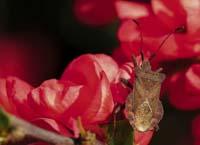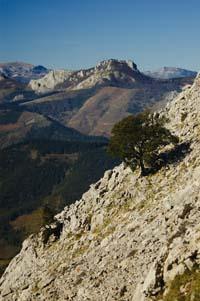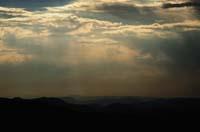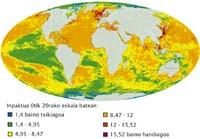The intervention of living beings

The Earth was born about 4,600 million years ago and the fossils of the first living beings are about 1.000 million years later. The conditions of life of that time are independent of the current ones. At the beginning of the Solar System, the main gases were helium and hydrogen. The earth was forming and was drunk. It was very hot and the skin was made and dissolved, melted. On the other hand, it had no large mass and weak gravity force could not retain the gases in its environment. The solar wind carried gases and until the wind calmed down, the Earth could not surround itself with an atmosphere.
Apparently, for millions of years there was no room on Earth. Over time, however, the first atmosphere was formed, began to rain and began to form oceans. The oceans modified the proportion of atmospheric gases. They absorbed a lot of carbon dioxide and many others passed to the land surface, to the rocks. This caused a decrease in the concentration of carbon dioxide in the atmosphere, which caused a decrease in temperature.
In the atmosphere of that time there was no free oxygen. Oxygen was formed, such as water dissociated or released by volcanoes, but it reacted quickly with other elements. For example, much oxygen disappeared, reacting with the iron of the rocks. However, the researchers do not know exactly what the composition of the atmosphere was then, since the weak evidence that exists is sometimes contradictory. However, knowing the composition of the atmosphere is essential to clarify how life occurred. It will take years to answer this question, but they know how life has transformed the planet.
"Undoubtedly, the Earth's own geology would not be today if it were not for life. And, on the contrary, if the life that has developed on the planet was not as it is due to the astronomical and geological characteristics of the Earth," says Dr. Koldo Nuñez Betelu in geology.

With photosynthesis, revolution
When the first living beings emerged, the revolution came. They did not need oxygen to live. However, some of these living beings are due to the accumulation of oxygen in the atmosphere. In fact, the appearance and expansion of the organisms that made photosynthesis broke the balance of gases in the atmosphere until then.
Revolutionary organisms are cyanobacteria. They arose on the continental coasts, almost 4,000 million years ago. They were not the first alive, but the truth is that cyanobacteria had the capacity to perform photosynthesis. That is to say, taking advantage of the energy of the Sun and from carbon dioxide and water, they produced glucids that released oxygen as a waste. Thus, between 2,500 and 3,000 million years ago, the situation changed. Oxygen was lethal to other bacteria, but cyanobacteria liked, so they spread easily. Thanks to them, the concentration of oxygen in the atmosphere gradually increased, reaching equal to the current: 21%.
Although for many ancient beings oxygen was poisonous, today most living beings need oxygen to live. It depends on him. The animals breathe oxygen and expel carbon dioxide; the plants breathe carbon dioxide and emit oxygen. Therefore, the plants, in general, perform both photosynthesis and respiration. In short, one of the most important interactions that occur between the atmosphere and all living beings, at least for the living, is respiration.

At the same time, it creates protection for life in the atmosphere. The ozone layer. It arises from the interaction between oxygen that accumulates in the atmosphere and ultraviolet rays, essential for the development of life on Earth. Its absorption capacity is of ultraviolet rays. If these ultraviolet rays continually crossed the atmosphere, they would cause serious damage to DNA and denaturalize proteins, so it would not be possible to live on Earth. "In short, photosynthesis is the main way to digest the energy of the Sun. And life needs energy to survive, and its strongest and most important source is the Sun," adds Nuñez Betelu. In addition, until the formation of the ozone layer, life was only possible at sea. Therefore, the formation of the ozone layer allowed life to slowly colonize dry aspects.
Dynamics of the Earth
Living beings have not only influenced the composition of the atmosphere, but also the terrestrial surface. For example, corals, rudists and other similar beings have fixed carbon dioxide, resulting in similar limestones and rocks, creating mountains and marine platforms... There are, among others, Aizkorri, Anboto, Gorbeia, Ernio, Izarraitz and many other mountains of Euskal Herria, witnesses who in the middle of the Cretaceous show that the tropical landscape prevailed in our seas. Being the shallow seabed, the mild climatology and the quality of the waters was very good, a good ecological corner was developed for the reproduction of the corals. These biotopes moved from the east of Gipuzkoa to the Cantabrian mountain range.
Little by little, large reefs were built in many regions of the Earth, resulting in huge accumulations of limestone. This process of construction was and continues to be tremendous and affected the dynamics of surface plates. According to Nuñez Betelu, the friction of the plates is directly related to the composition of the plates and the rocks on them.

Thus, the plates that form the earth's crust behave in one way or another, directly or indirectly, due to life, among other things, because the reefs are built by living beings. It is to assume that what is happening today on the reefs will have some influence. "With this I do not mean that the destructions that are taking place now are going to change in a near dynamic of Earth's plate tectonics, but everything is related," underlines geologist Nuñez Betelu. "Therefore, with a long way, the family and the planet itself of those who live on Earth, as Gaia's hypothesis advocated long ago."
In short, the development of life modified the chemical compositions of the seas, the atmosphere and the rocks. Life has allowed the development of the Earth's atmosphere, which has allowed the planet to be protected. Without life, oxygen will gradually be destroyed, heating and changing the atmosphere, as has happened on other planets.
And in the future what?
However, scientists do not only worry about the past. The changes that are now taking place are also being studied closely, especially because they perceive that they can influence the future. In fact, in the last century we are emitting a lot of carbon dioxide into the air, which has meant an increase in the concentration of this gas in the atmospheric layer closest to the earth's surface. At the same time, the most significant temperature increase of the last millennium seems to have occurred. on the surface of the twentieth century.

Besides the temperatures, there are other signs of warming of the Earth: the polar ice layer and the mountain glaciers in general have receded and the oceans have heated. Why have all these changes occurred? Has anything to do with human activity? There does not seem to be a clear answer, at least among researchers there is no total agreement.
While the Earth was developing geologically, on the surface there was also another phenomenon of great importance: biological evolution, that is, the development of living beings. Undoubtedly, life has since built its own environment and continues to build. From the moment of the creation of the Earth, the planet continues in constant change and it is not predictable how it will be within millions of years. If life or living beings continue to function until now, one knows.








